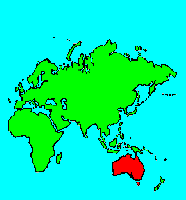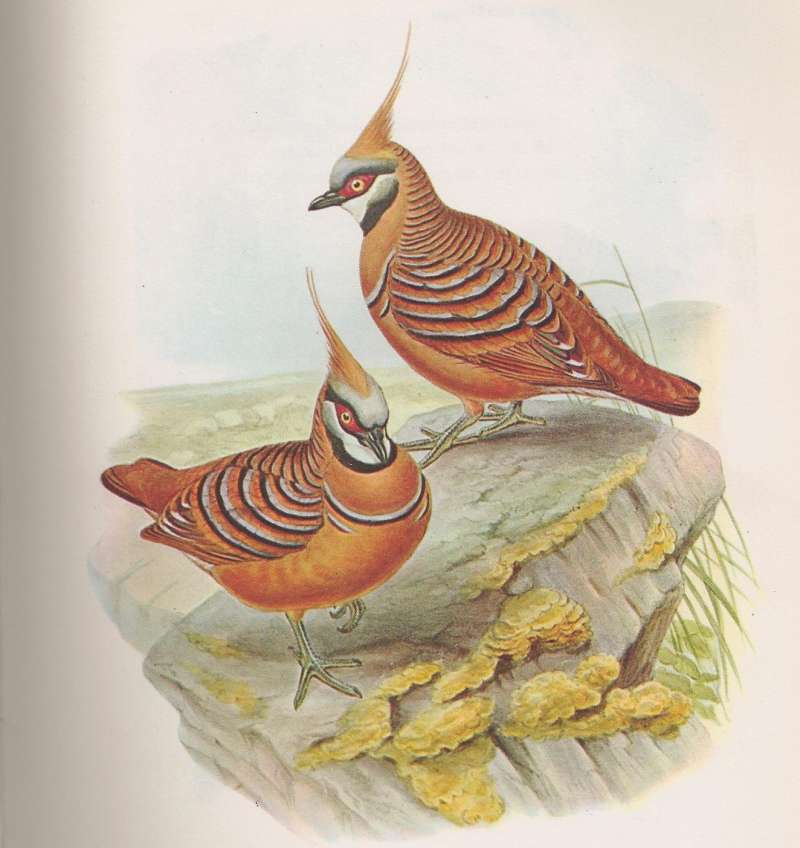SPECIES INFO
Australian spinifex pigeon (Geophaps plumifera) is found in two main disjoint areas in Australia. There is a population ferruginea found in northern Western Australia, and a population leucogaster found in a large area from the northern part of Western Australia east to Queensland and south to northern South Australia. Both populations of this 8 to 9 inch pigeon have a brown pointed spire on the top of the head. The face is black and white with a large red eye patch. The throat and upper breast is pale brown. There is a darker brown-black line across the center breast. In the western race ferruginea the middle and lower breast is brown. In the central race leucogaster there is a white patch above the black breast center line, and also a white lower breast.
Per the drawing in Goodwin, this lifeform reminds one of a small quail. the overall color is brown. There is a spine on top of the head. The white neck is bordered below by a black mark. The breast and belly are marked with brown, black and white.
Summarizing the three subspecies: The nominate subspecies is found in northern Western Australia and the western Northern Territory. The subspecies ferruginea is found in WC Western Australia. The subspecies leucogaster is found in inland Australia to NE Australia.The pigeons of Australia in the genus Geophaps are generally found in open plains and grasslands. There are four species and extra races in this genus that is found only in Australia. These are brownish or pale species. These birds range from about 8 inches to 14 inches in length. Two species have tall pointed head spires.
With over three hundred species in the pigeon and dove family (Columbidae) found world wide, we have broken this family into two parts based on geographical origin with the Old World versus the New World as the criteria. This is the Old World portion.
Pigeon and Dove group (Family Columbidae) are a group of about 290 species of birds that are found worldwide.
Pigeons and Doves (Order Columbiformes) contains three families. The dodos (Family Raphidae) are extinct. The other families are the sandgrouse (Family Pteroclidae) and pigeons (Family Columbidae).
Clements in 2007 counted 308 pigeons and doves and Clements also counted 16 sandgrouse. (He, however, placed the sandgrouse in their separate order, Pterocliformes.)
Aves contains about 8,650 different species of living birds known to science. Each year about one new species is discovered in some remote rain forest or remote island. In addition, scientists have been raising many subspecies to full species status which may raise the species count to 10,000. Birdlife recognizes 10,027 species as of 2011.
However, each year about one species goes extinct. The rate of extinction is increasing, and the rate of new discovery is decreasing, so that the number of bird species will soon begin to decline rapidly. Although different taxonomists would organize the birds differently, there are approximately twenty-seven orders of birds. These orders are broken down into about one hundred and fifty-five different families.
Recent research of the genetic structure of some of the shore birds and owls would indicate that the present organization of orders and families should have some modification.
The birds are a worldwide group of animals that are characterized by having the front limbs modified into wings that are used for flying. Perhaps the most unique feature of the birds is the feathers. These feathers are made up of a central support called a quill and a series of small filaments that are hooked together as barbs.
For many years it was believed that Archaeopteryx discovered in Bavaria was the oldest bird from about 150 million years ago. However, in l986, Sankar Chattterjee, a Texas paleontologist, reportedly discovered a bird in the genus Protoavis that lived about 225 million years ago.
When this project was begun in 1978, we used Austin & Singer for bird taxonomy. Since then, we have adopted many changes, but have kept some older concepts that are still found widely in the literature. Recently, we have used Clements and Howard & Moore. Very recently, we have used Monroe and Sibley for the higher taxonomy of the perching birds.
Backboned Animals (Phylum Chordata) are the most advanced group of animals on earth. These animals are characterized by having a spinal cord or backbone. Most members have a clearly defined brain that controls the organism through a spinal cord. Fish, amphibians, reptiles, birds, and mammals are in this phylum.
Currently, some taxonomists believe that the fish should be divided into two groups (sharks and regular fishes) and that there are some other primitive groups in the phylum such as hagfish or lampreys.
Animal Kingdom contains numerous organisms that feed on other animals or plants. Included in the animal kingdom are the lower marine invertebrates such as sponges and corals, the jointed legged animals such as insects and spiders, and the backboned animals such as fish, amphibians, reptiles, birds, and mammals.


